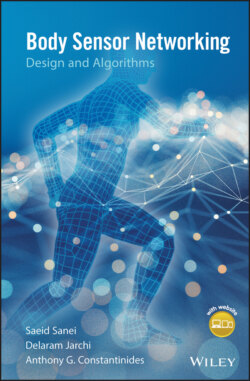Читать книгу Body Sensor Networking, Design and Algorithms - Saeid Sanei - Страница 14
1.4 Layout of the Book
ОглавлениеThis monograph consists of 15 chapters and has been designed to cover all aspects of BSNs, starting with human body measurable or recordable biomarkers. Chapter 2 is dedicated to understanding these biomarkers, including physical, physiological, and biological measurable quantities. In Chapter 3, sensors, sensor classification, and the quantities measured by different sensors are described. In this chapter, the structures of the sensors for the applications listed in Chapter 2 are detailed. In Chapter 4, more popular and ambulatory sensor systems used in clinical departments and intensive care units are discussed and some examples of their recordings and analysis explained. This discussion continues in Chapter 5, where sleep, as a specific state of human body, is analysed. This chapter includes discussion of various sleep measurement modalities which are more popular and of interest today to researchers. Chapter 6 covers the area of noninvasive, intrusive, and nonintrusive measurement approaches. The objective of this chapter is to introduce the techniques and sensors for nonintrusive or contactless monitoring of major human vital signs, such as breathing, heart rate, and blood oxygen saturation level.
Next, Chapter 7, covers the important concept of gait analysis, recognition, and monitoring. The outcome of this study has a major application in assistive technology, rehabilitation, and assistive robotics. Chapter 8 brings together a wide range of techniques and research approaches in health monitoring. These address the important daily assisted living problems of disabled and older people, and patients with degenerative diseases, and the solutions being currently researched. In Chapter 9 numerous machine learning techniques used for both sensor networks and bioinformatics are explained. This chapter includes most popular, advanced, and very recent machine learning methods for clustering, classification, and feature learning. Support vector machines, reinforcement learning, and different deep neural networks are also included in this chapter. Some examples of machine learning for sensor networks conclude this chapter.
Signal processing techniques and their wide range of applications are covered in Chapter 10. This long chapter explains useful approaches in time, frequency, and multidimensional spaces. Multiresolution analysis, synchro-squeezing wavelet transform, and adaptive cooperative filtering are addressed. At the end of this chapter various signal processing platforms established recently are reviewed. Chapter 11 is devoted to communication systems for BSNs. Short-range communication methods, limitations, and barriers; problems with communication channels and their modelling; linking between body and public networks; and routing methods for BSNs are extensively explained in this chapter. The important topic of energy harvesting for sensor networks is covered in Chapter 12. Advanced techniques in harvesting kinetic, radiant, thermal, chemical, and biochemical energy are explored. At the end of this chapter, topology control and energy prediction, two hot research topics, are introduced.
Chapter 13 covers a wide range of studies of and practical approaches to solving information and network security problems. In addition to general security and privacy preserving techniques, some problems related to patient and clinical data and their importance are discussed in this chapter. QoS, as the major requirement for BSNs are emphasised in this chapter. In Chapter 14 various hardware and software platforms for developing sensor networks currently employed for BSN design are discussed and some practical examples reviewed. Finally, in Chapter 15, the book is summarised, the main topics highlighted, and some suggestions for future research in BSN proposed.
